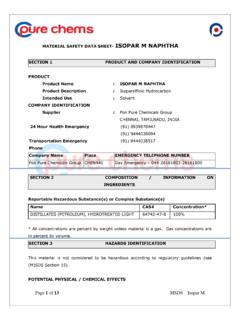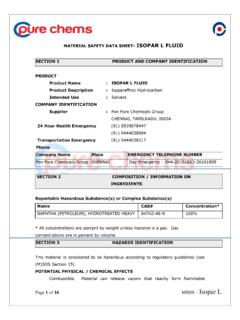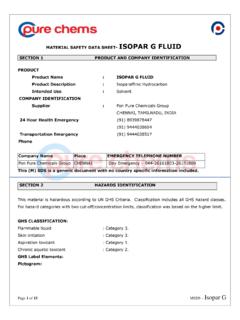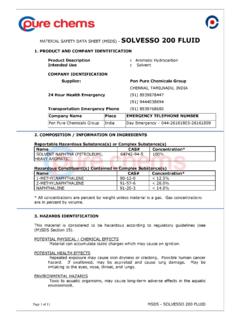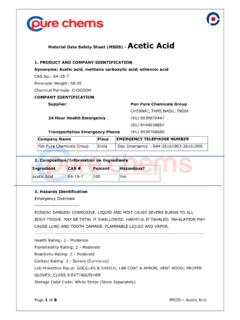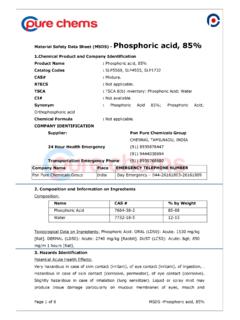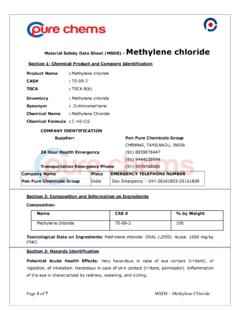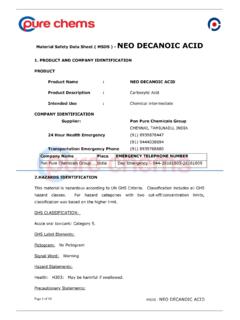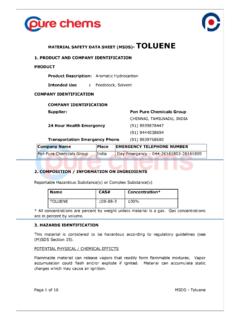Transcription of MATERIAL SAFETY DATA SHEET- ISOPAR L FLUID …
1 MATERIAL SAFETY data sheet - ISOPAR L FLUID . SECTION 1 PRODUCT AND COMPANY IDENTIFICATION. PRODUCT. Product Name : ISOPAR L FLUID . Product Description : Isoparaffinic Hydrocarbon Intended Use : Solvent COMPANY IDENTIFICATION. Supplier : Pon Pure Chemicals Group CHENNAI, TAMILNADU, INDIA. 24 Hour Health Emergency (91) 8939878447. (91) 9444038694. Transportation Emergency (91) 9444038517. Phone Company Name Place EMERGENCY TELEPHONE NUMBER. Pon Pure Chemicals Group CHENNAI Day Emergency 044-26161803-26161809. SECTION 2 COMPOSITION / INFORMATION ON. INGREDIENTS. Reportable Hazardous Substance(s) or Complex Substance(s). Name CAS# Concentration*. NAPHTHA (PETROLEUM), HYDROTREATED HEAVY 64742-48-9 100%. * All concentrations are percent by weight unless MATERIAL is a gas. Gas concentrations are in percent by volume. SECTION 3 HAZARDS IDENTIFICATION. This MATERIAL is considered to be hazardous according to regulatory guidelines (see (M)SDS Section 15).
2 POTENTIAL PHYSICAL / CHEMICAL EFFECTS. Combustible. MATERIAL can release vapors that readily form flammable Page 1 of 16 MSDS ISOPAR L. mixtures. Vapor accumulation could flash and/or explode if ignited. MATERIAL can accumulate static charges which may cause an ignition. POTENTIAL HEALTH EFFECTS. If swallowed, may be aspirated and cause lung damage. May be irritating to the eyes, nose, throat, and lungs. NFPA Hazard ID: Health: 1 Flammability: 2 Reactivity: 0. HMIS Hazard ID: Health: 1 Flammability: 2 Reactivity: 0. NOTE: This MATERIAL should not be used for any other purpose than the intended use in Section 1 without expert advice. Health studies have shown that chemical exposure may cause potential human health risks which may vary from person to person. SECTION 4 FIRST AID MEASURES. INHALATION. Remove from further exposure. For those providing assistance, avoid exposure to yourself or others. Use adequate respiratory protection.
3 If respiratory irritation, dizziness, nausea, or unconsciousness occurs, seek immediate medical assistance. If breathing has stopped, assist ventilation with a mechanical device or use mouth-to-mouth resuscitation. SKIN CONTACT. Wash contact areas with soap and water. Remove contaminated clothing. Launder contaminated clothing before reuse. EYE CONTACT. Flush thoroughly with water. If irritation occurs, get medical assistance. INGESTION. Seek immediate medical attention. Do not induce vomiting. Page 2 of 16 MSDS ISOPAR L. NOTE TO PHYSICIAN. If ingested, MATERIAL may be aspirated into the lungs and cause chemical pneumonitis. Treat appropriately. SECTION 5 FIRE FIGHTING MEASURES. EXTINGUISHING MEDIA. Appropriate Extinguishing Media: Use water fog, foam, dry chemical or carbon dioxide (CO2) to extinguish flames. Inappropriate Extinguishing Media: Straight Streams of Water FIRE FIGHTING. Fire Fighting Instructions: Evacuate area.
4 Prevent runoff from fire control or dilution from entering streams, sewers, or drinking water supply. Firefighters should use standard protective equipment and in enclosed spaces, self-contained breathing apparatus (SCBA). Use water spray to cool fire exposed surfaces and to protect personnel. Unusual Fire Hazards : Combustible. Hazardous Combustion Products: Smoke, Fume, Incomplete combustion products, Oxides of carbon FLAMMABILITY PROPERTIES. Flash Point [Method] : >61C (142F) [ ASTM D-93]. Flammable Limits (Approximate volume % in air): LEL: UEL: Auto ignition Temperature : 335 C (635 F). SECTION 6 ACCIDENTAL RELEASE MEASURES. NOTIFICATION PROCEDURES. In the event of a spill or accidental release, notify relevant authorities in accordance with all applicable regulations. PROTECTIVE MEASURES. Avoid contact with spilled MATERIAL . Warn or evacuate occupants in surrounding and downwind areas if required due to toxicity or flammability of the MATERIAL .
5 See Section 5 for fire fighting information. See the Hazard Page 3 of 16 MSDS ISOPAR L. Identification Section for Significant Hazards. See Section 4 for First Aid Advice. See Section 8 for Personal Protective Equipment. SPILL MANAGEMENT. Land Spill: Eliminate all ignition sources (no smoking, flares, sparks or flames in immediate area). Stop leak if you can do it without risk. All equipment used when handling the product must be grounded. Do not touch or walk through spilled MATERIAL . Prevent entry into waterways, sewer, basements or confined areas. A vapor suppressing foam may be used to reduce vapors. Use clean non-sparking tools to collect absorbed MATERIAL . Absorb or cover with dry earth, sand or other non-combustible MATERIAL and transfer to containers. Large Spills: Water spray may reduce vapor; but may not prevent ignition in closed spaces. Recover by pumping or with suitable absorbent. Water Spill: Stop leak if you can do it without risk.
6 Eliminate sources of ignition. Warn other shipping. Remove from the surface by skimming or with suitable absorbents. If the Flash Point exceeds the Ambient Temperature by 10 degrees C or more, use containment booms and remove from the surface by skimming or with suitable absorbents when conditions permit. If the Flash Point does not exceed the Ambient Air Temperature by at least 10C, use booms as a barrier to protect shorelines and allow MATERIAL to evaporate. Seek the advice of a specialist before using dispersants. Water spill and land spill recommendations are based on the most likely spill scenario for this MATERIAL ; however, geographic conditions, wind, temperature, (and in the case of a water spill) wave and current direction and speed may greatly influence the appropriate action to be taken. For this reason, local experts should be consulted. Note: Local regulations may prescribe or limit action to be taken.
7 ENVIRONMENTAL PRECAUTIONS. Large Spills: Dike far ahead of liquid spill for later recovery and disposal. Prevent entry into waterways, sewers, basements or confined areas. Page 4 of 16 MSDS ISOPAR L. SECTION 7 HANDLING AND STORAGE. HANDLING. Avoid contact with skin. Prevent small spills and leakage to avoid slip hazard. MATERIAL can accumulate static charges which may cause an electrical spark (ignition source). When the MATERIAL is handled in bulk, an electrical spark could ignite any flammable vapors from liquids or residues that may be present ( , during switch-loading operations). Use proper bonding and/or ground procedures. However, bonding and grounds may not eliminate the hazard from static accumulation. Consult local applicable standards for guidance. Loading/Unloading Temperature : [Ambient]. Transport Temperature : [Ambient]. Transport Pressure : [Ambient]. Static Accumulator: This MATERIAL is a static accumulator.
8 A liquid is typically considered a nonconductive, static accumulator if its conductivity is below 100 pS/m (100x10E-12 Siemens per meter) and is considered a semiconductive, static accumulator if its conductivity is below 10,000 pS/m. Whether a liquid is nonconductive or semiconductive, the precautions are the same. A number of factors, for example liquid temperature, presence of contaminants, anti-static additives and filtration can greatly influence the conductivity of a liquid. STORAGE. The container choice, for example storage vessel, may effect static accumulation and dissipation. Keep container closed. Handle containers with care. Open slowly in order to control possible pressure release. Store in a cool, well-ventilated area. Storage containers should be grounded and bonded. Fixed storage containers, transfer containers and associated equipment should be grounded and bonded to prevent accumulation of static charge.
9 Storage Temperature : [Ambient]. Page 5 of 16 MSDS ISOPAR L. Storage Pressure : [Ambient]. Suitable Containers/Packing : Tankers; Tank Trucks; Railcars; Barges;. Drums Suitable Materials and Coatings (Chemical Compatibility): Inorganic Zinc Coatings; Epoxy Phenolics; Teflon; Neoprene; Stainless Steel; Carbon Steel Unsuitable Materials and Coatings: Vinyl Coatings; Natural Rubber; Butyl Rubber; Ethylene-proplyene-diene monomer (EPDM). SECTION 8 EXPOSURE CONTROLS / PERSONAL PROTECTION. EXPOSURE LIMIT VALUES. Exposure limits/standards (Note: Exposure limits are not additive). Source Form Limit / Standard NOTE Source NAPHTHA Vapor. RCP - 1200 171 Total Exxon Mobil (PETROLEUM), TWA mg/m3 ppm Hydrocarbons HYDROTREATED. HEAVY. NOTE: Limits/standards shown for guidance only. Follow applicable regulations. ENGINEERING CONTROLS. The level of protection and types of controls necessary will vary depending upon potential exposure conditions.
10 Control measures to consider: Adequate ventilation should be provided so that exposure limits are not exceeded. Use explosion-proof ventilation equipment. PERSONAL PROTECTION. Personal protective equipment selections vary based on potential exposure conditions such as applications, handling practices, concentration and ventilation. Information on the selection of protective equipment for use with this MATERIAL , as provided below, is based upon intended, normal usage. Page 6 of 16 MSDS ISOPAR L. Respiratory Protection: If engineering controls do not maintain airborne contaminant concentrations at a level which is adequate to protect worker health, an approved respirator may be appropriate. Respirator selection, use, and maintenance must be in accordance with regulatory requirements, if applicable. Types of respirators to be considered for this MATERIAL include: Half-face filter respirator For high airborne concentrations, use an approved supplied-air respirator, operated in positive pressure mode.
